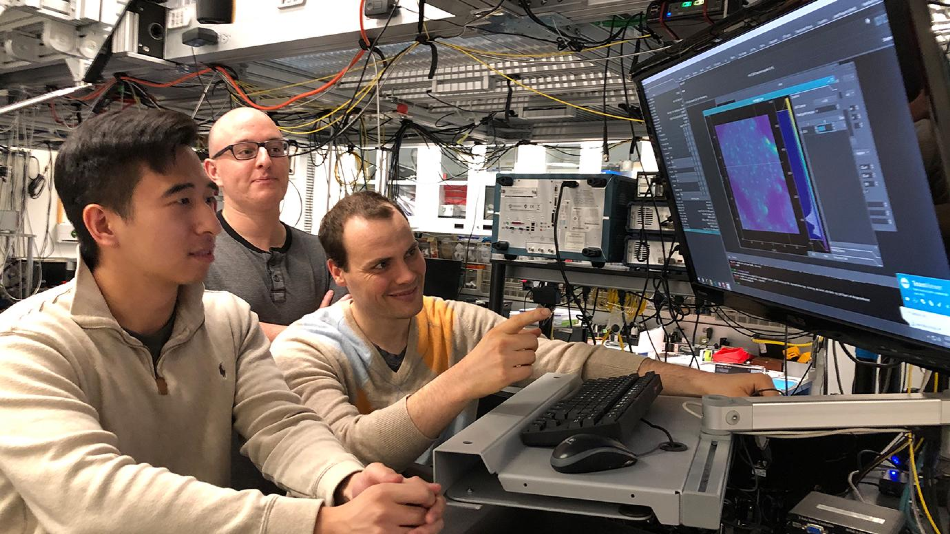Aug 14 2020
A research team from the Pritzker School of Molecular Engineering at the University of Chicago has identified a simple modification that can be made to quantum systems, that allows them to maintain coherence 10,000 times longer than before.
The ability to harness quantum technology could pave the way for new, fascinating possibilities. But before that can be achieved, researchers should first coax the quantum systems to last much longer than just a few millionths of a second.
While the new method has been tested only on a specific group of quantum systems—known as solid-state qubits—the researchers believe that it should also be relevant to many other types of quantum systems and can thus transform quantum computing, communication, and sensing applications.
 From left: Scientists Kevin Miao, Chris Anderson, and Alexandre Bourassa work on quantum research in the Awschalom lab at the University of Chicago’s Pritzker School of Molecular Engineering. Image Credit: University of Chicago.
From left: Scientists Kevin Miao, Chris Anderson, and Alexandre Bourassa work on quantum research in the Awschalom lab at the University of Chicago’s Pritzker School of Molecular Engineering. Image Credit: University of Chicago.
The results of the study were published in the Science journal on August 13th, 2020.
This breakthrough lays the groundwork for exciting new avenues of research in quantum science. The broad applicability of this discovery, coupled with a remarkably simple implementation, allows this robust coherence to impact many aspects of quantum engineering. It enables new research opportunities previously thought impractical.
David Awschalom, Study Lead Author and Liew Family Professor, Pritzker School of Molecular Engineering, University of Chicago
Awschalom is also the director of the Chicago Quantum Exchange and a senior scientist at the Argonne National Laboratory.
At the atomic level, the world works based on the rules of quantum mechanics; these rules are quite different from what people see around them in their day-to-day lives.
Such different rules might transform into technologies, such as highly powerful computers and almost unhackable networks. In this regard, the U.S. Department of Energy has released a blueprint for the upcoming quantum internet in an event held at the University of Chicago on July 23rd, 2020.
However, rudimentary engineering challenges continue to persist: quantum states require a highly stable environment, because background noise coming from stray electromagnetic fields, temperature fluctuations, or vibrations can easily disturb them.
Therefore, investigators are always searching for ways to tweak their experimental setups to maintain coherence of the useful quantum states for as long as possible. Physically separating the system from noisy surroundings is a standard technique, but this method can be complex and cumbersome. In another method, all the materials are made as pure as possible, which can be quite expensive. The method developed by the team from the University of Chicago takes a different approach which seems to be much easier to implement..
With this approach, we don’t try to eliminate noise in the surroundings; instead, we “trick” the system into thinking it doesn’t experience the noise.
Kevin Miao, Study First Author and Postdoctoral Researcher, Pritzker School of Molecular Engineering, University of Chicago
The researchers applied an additional continuous alternating magnetic field along with the standard electromagnetic pulses used for controlling quantum systems. Accurate adjustment of this magnetic field can allow the researchers to rotate the electron spins. The additional of the continuous field enables the system to effectively “tune out” the external noise.
“To get a sense of the principle, it’s like sitting on a merry-go-round with people yelling all around you,” explained Miao. “When the ride is still, you can hear them perfectly, but if you’re rapidly spinning, the noise blurs into a background.”
This simple addition enabled the system to remain coherent for up to 22 ms, that is, four orders of magnitude higher when compared to the system without the modification—and also longer than any electron spin system reported before. (For comparison purposes, a blink of an eye takes approximately 350 ms.)
The system can almost entirely remove the effects of some kinds of electromagnetic noise, physical vibrations, and temperature changes, all of which often destroy quantum coherence. According to the researchers, the simple fix could lead to new discoveries in many different field of quantum technology.
This approach creates a pathway to scalability. It should make storing quantum information in electron spin practical. Extended storage times will enable more complex operations in quantum computers and allow quantum information transmitted from spin-based devices to travel longer distances in networks.
David Awschalom, Study Lead Author and Liew Family Professor, Pritzker School of Molecular Engineering, University of Chicago
While the tests were conducted in a solid-state silicon carbide quantum system, the team believes that the latest method should also have analogous effects in other kinds of quantum systems, like molecular quantum systems and superconducting quantum bits. Such levels of versatility are quite extraordinary for this engineering innovation.
“There are a lot of candidates for quantum technology that were pushed aside because they couldn’t maintain quantum coherence for long periods of time,” added Miao. “Those could be re-evaluated now that we have this way to massively improve coherence.
“The best part is, it’s incredibly easy to do,” Miao further added. “The science behind it is intricate, but the logistics of adding an alternating magnetic field are very straightforward.”
The study also involved other scientists from the University of Chicago, including graduate student Joseph Blanton, postdoctoral researcher Chris Anderson, graduate students Alexandre Bourassa and Alex Crook, and also Gary Wolfowicz, a scientist from Argonne National Laboratory.
Co-authors of the study are Hiroshi Abe and Takeshi Ohshima from Japan’s National Institutes for Quantum and Radiological Science and Technology.
For their study, the researchers employed resources at the Pritzker Nanofabrication Facility. To commercialize the discovery, they are presently working with the Polsky Center for Entrepreneurship and Innovation.
Journal Reference:
Miao, K. C., et al. (2020) Universal coherence protection in a solid-state spin qubit. Science. doi.org/10.1126/science.abc5186.